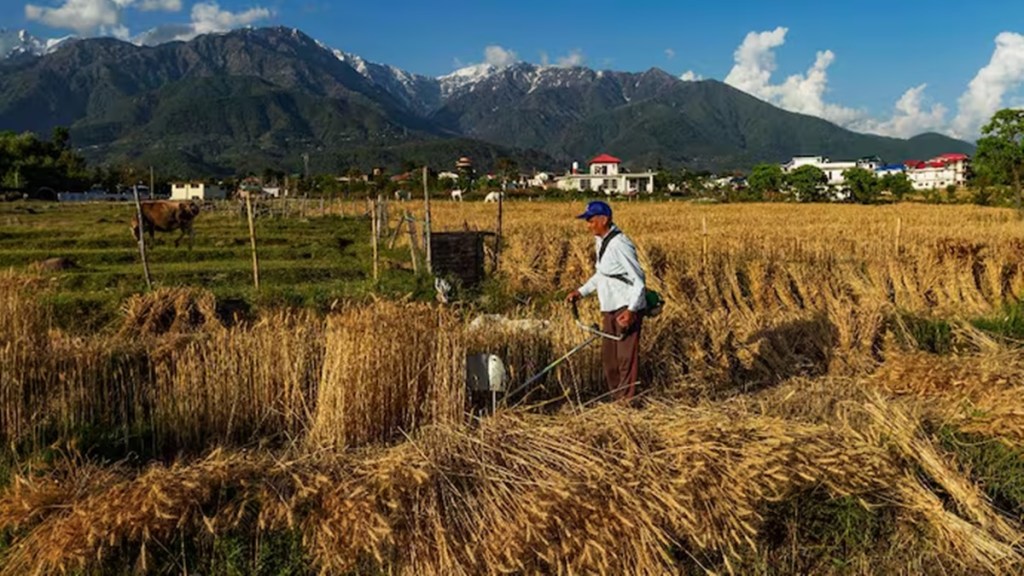To estimate real time output of various agricultural commodities, the government is aiming to cover all the states under digital crop survey (DCS) by next kharif season (2025-26) crop year.
It will eventually replace the manual Patwari-Girdawari system and establish a crop-sown registry for periodic crop yield estimation through gathering of real-time crop-sown details directly from the field through a mobile interface.
The survey is expected to address the issue of wide variations in output projections of various crops by the government as well as trade which often lead to market imbalance
“The survey uses technologies including remote sensing, geospatial analysis, and artificial intelligence to generate crop production data,” an official said. The aim of the digital survey is to standardize agricultural data by creating a unified crop registry that records details such as crop types, sowing patterns, and irrigation sources consistently across regions.
Under DCS so far has been initiated in 15 states across 485 districts in the both kharif and rabi seasons of the current crop year (2024-25). The survey has covered around 3 lakh villages with data collection from diverse agricultural and agro-climatic zones.
States especially Uttar Pradesh, Bihar, Madhya Pradesh, Tamil Nadu, Andhra Pradesh, Assam, and Rajasthan have each completed over 90% of their targeted plots for the Kharif season under the survey. The survey has led to a significant increase in reported agricultural areas in 21 districts, according to officials.
Official said that aim is to ensure that the survey reaches at least one district in each state, thereby bringing comprehensive method for national agricultural data.
Sources told FE traditionally under the Patwari-Gardawar system the state revenue officials collect data on crop and land records manually which is prone to human errors leading to distortion in the estimation of crop area and other farm-level information.
“These manual surveys used paper-based methods that were slow to process and often led to delays in decision-making,” an official said.
Officials said as the digital survey gathers a substantial database of crop images, these can serve as training data for machine learning models. This will facilitate the use of artificial intelligence (AI) to do crop survey, analyse crop health and growth patterns using drones and satellite imagery, allowing for more accurate and comprehensive agricultural surveys
This survey is being conducted through various digital applications initiated under the ministry of agriculture’s Rs 2,817 crore digital agriculture mission.
According to an official note, the data generated from the crop survey will assist government agencies in implementing minimum support price (MSP) based procurement, providing crop insurance and credit card-linked crop loans, and developing systems for the balanced use of fertilizers, among other measures.
The integration of real-time data collection with AI analytics allows for immediate detection of anomalies in crop growth or health, such as pest infestations or disease outbreaks, an official said.
The digital public infrastructure (DPI) project aimed at streamlining and scheme delivery to farmers has three components – farmers’ registry, geo-referenced village maps and crop sown registry.
The DPI aims to integrate state and central digital systems to provide a range of farmer-centric services, including information on livestock, fisheries, soil health, and available benefits.
(ends)
BOX: Over 48 million farmers get digital IDs linked to land records
To develop a database of farmers which is linked to their land records, the agriculture ministry in collaboration with states has provided digital IDs to over 48 million farmers across 12 states so far, according to a senior official.
These unique IDs contain the details of the farmers’ land holding, crops grown in the field and other details and are updated with every land mutation.
Most of the farmers’ IDs are generated in the states of —Uttar Pradesh (12 million ), Maharashtra (8.3 million), Madhya Pradesh (7.3 million), Rajasthan (6.7 million), Gujarat (4.1 million), Andhra Pradesh (4 million) and Tamil Nadu (2.5 million). Assam, Chhattisgarh, Odisha, and Bihar are the other states who have started the programme for providing IDs.
According to estimates, there are 140 million farmers in the country and out of these around 35% – 40% do not own lands and engaged in tenancy farming. Currently the farmers registry covers those who have land holdings, while tenant farmers who do not own lands will be included in the subsequent phase, according to an official note.
Officials said the digital agriculture mission involves Agri Stack — farmers registry, village land maps registry, crop registry and Krishi decision support system, which will leverage geospatial data, drought and flood monitoring, weather and satellite data, and groundwater availability information to assist farmers in making informed decisions
The agriculture ministry’s move to develop a digital database of farmers is based on Karnataka’s Fruits Farmer Registration & Unified Beneficiary Information System (FRUITS) software which facilitates single registration using an Aadhar card and state’s Bhoomi digitised land record system for authenticating ownership.
Under AgriStack, part of the government’s digital public infrastructure initiative to streamline services and delivery of scheme benefits to farmers including PM Kisan and crop insurance, 110 million digital identities, similar to Aadhaar, will be generated over the next couple of years.

